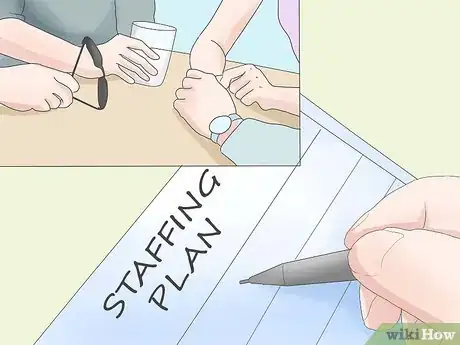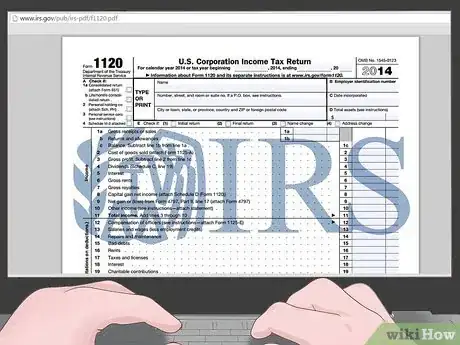This article was written by Jennifer Mueller, JD. Jennifer Mueller is an in-house legal expert at wikiHow. Jennifer reviews, fact-checks, and evaluates wikiHow's legal content to ensure thoroughness and accuracy. She received her JD from Indiana University Maurer School of Law in 2006.
There are 15 references cited in this article, which can be found at the bottom of the page.
wikiHow marks an article as reader-approved once it receives enough positive feedback. In this case, 94% of readers who voted found the article helpful, earning it our reader-approved status.
This article has been viewed 24,203 times.
It may not be difficult to come up with a good idea for a non-profit organization – but realizing that idea can be incredibly difficult in practice. In fact, running a non-profit organization may be more difficult than running a for-profit company of a similar size. Non-profits have particular organization and governmental reporting requirements that don't exist in other contexts, and the start-up process differs from state to state. Becoming a non-profit isn't easy, but fulfilling a need in your community can be very rewarding.
Steps
Forming a Corporation
-
1Research the needs of your community. Before you start your non-profit, you need to make sure there will be a significant demand for the services you provide.[1]
- This is similar to researching the demand and market for your product or service if you are starting a small business.
- Finding a unique niche and being able to demonstrate a significant demand for your services will be key to attracting donations when you begin fundraising and drumming up support for your non-profit.
- You may need to conduct surveys among the people you want to help to determine if some other organization in your community is providing similar services.
- To be sustainable, you must be able to demonstrate to potential donors that your organization will make a significant impact in the community and on people's lives.[2]
- For example, a group of undergraduate students at the University of California, Santa Barbara started Environmental Education for the Next Generation in 2009. EENG brings free environmental education programs to California's cash-strapped public schools. Since its inception, the non-profit has grown from a single classroom to an organization with four regional chapters and 220 volunteers that serve more than 3,000 children.[3]
- If another organization exists in your community that already does something similar to what you want to do, consider working with that organization or approaching it to serve as a fiscal sponsor for your organization.[4]
-
2Find your state association of non-profits. Your state association will have many resources on starting a non-profit, as well as experts who can assist you with your planning and development.[5]Advertisement
-
3Develop a business plan. As with any business, you need to develop a plan for the growth and continued operation of your non-profit organization.[8]
- Taking time to draft a detailed business plan at the beginning of the process will save you a lot of time and effort later on. For example, you may be able to copy parts of your business plan into your application for tax-exempt status, or use it in fundraising brochures or letters.[9]
- Outline all aspects of your plan, including your organizational structure, the mission for your non-profit, and possible marketing and fundraising efforts.[10]
-
4Draw up a budget. You must start with a good understanding of how much it will cost to operate your non-profit so you know how much money you need to raise.[11]
- You will need to have a good sense not only of the fixed costs to start your non-profit, including state and federal fees and the time it will take to complete that paperwork, but also any necessary costs for infrastructure and development.[12]
- For example, you may need to rent office space for your non-profit, or you may be able to run it out of your living room – at least at first. If you need to rent a physical space, though, the initial costs of finding and securing a location should be included in your budget.
- Your organization also will need supplies. For example, if you plan on opening a soup kitchen, you will need plates, bowls, and cups and utensils, as well as space to cook and clean.
- Even if your non-profit will exist mostly in virtual space on the internet, you still will have material costs associated with the business such as fees for domain registration and hosting of your website.
- Having a solid understanding of the daily operating expenses for your non-profit will help you determine how much money you need to raise on a regular basis.[13]
- Consider the economic climate in your area, as well as projections for the future, as this will have an impact on the amount of money you're able to raise and the continued financial viability of your non-profit.[14]
- For example, University of Maryland undergraduate student Ben Simon created a food aid program that became the Food Recovery Network. The organization started out simply as a plan to feed the homeless with unused food from college campus dining facilities. Over time, Simon began collecting food from private restaurants as well, and eventually expanded onto other campuses. The government and politics major leveraged his educational resources to enter and win two social entrepreneurship contests as well as outside seed money before registering as a 501(c)(3) non-profit.[15]
-
5Decide who will be involved. Even though your non-profit does not yet exist, you should have a good idea of who you want to be on your board and what their roles will be in the start-up organization.
- Not only must you recruit talented and dedicated board members, you must find passionate and driven people to staff your organization.[16]
- Try to include people who can provide the services you need, such as attorneys or accountants, and who will provide a little creative tension on your board. Including only close friends and family on your initial board can be a recipe for disaster later on when they are unwilling to challenge your decisions.[17]
- Your staffing needs will vary depending on the type of organization you're starting and where you will be located. For example, if you are running a non-profit that will exist mostly online, you'll want to hire web designers and social media experts.
- Having a large staff of volunteers can help demonstrate community support and involvement in your project, and this may increase donations.[18]
- Keep in mind that many states require a specific minimum number of board members. For example, in New York you must have at least three directors, and you must have a president, vice president, a secretary and a treasurer on your board. One person may hold more than one office, with the exception of president and secretary.[19]
- Some states also have residency, age, or other requirements for who may serve as members of a non-profit board.[20]
-
6Find and register your name. Search the secretary of state's database in the state where you want to establish your nonprofit to make sure your name is unique.
- Your first step to becoming a non-profit is to incorporate your organization at the state level. In most states this is accomplished through the secretary of state.
- Incorporation of a non-profit is a similar process to creating a for-profit corporation in most respects, but you must take some extra steps including applying for tax-exempt status.
- To incorporate your organization, you must find a name that is unique among all registered corporations in your state – non-profit and for-profit alike.
- You may have to pay a fee to reserve your unique name. For example, in Alabama you must pay a $28 fee to reserve your name.[21]
- While you don't necessarily have to incorporate your organization to get federal tax-exempt status, it may be required by your state.[22]
-
7Complete the required paperwork. Each state has its own paperwork required for incorporation and for designation as a non-profit.[23]
- At a minimum, you must file articles of incorporation and charitable organization paperwork. Some states require additional documents such as a certificate of disclosure or proof of your corporate name.[24]
- You may have to file a different form for your articles of incorporation depending on the type of non-profit your organization is. For example, California has four different forms depending on the type of non-profit, including separate forms for a public benefit corporation or a religious corporation.[25]
- When you've finished filling out all the necessary paperwork and creating your organizational documents, you'll want to make enough copies to have one for the non-profit's files and at least one for each board member.
- Your local association for non-profits will have state-specific resources and forms, as well as experts to guide you through the process.[26]
- In many states, you also must publish your articles of incorporation in a newspaper of record and file a proof of publication along with your other documents.[27]
-
8File your paperwork and pay the required fees. Once you've completed your paperwork and made copies, you must file it with the secretary of state and pay all fees required to register your corporation.[28]
- The amount you'll pay in fees to incorporate your non-profit will vary depending on the state where you start your organization. For example, in California you must pay $30 if you are mailing your incorporation documents or $45 if you are filing them in person.[29]
- In some states you may have the option of paying an additional fee for expedited filing. Check processing times with your state before you file to determine whether you might prefer expedited processing.[30]
Applying for Tax Exemptions
-
1Determine if you're eligible for tax-exempt status. Not every non-profit organization necessarily is eligible for federal tax-exempt status.
- The IRS lists certain purposes that qualify, such as religious or educational purposes. To be eligible for tax-exempt status, your organization must exist to further one of these purposes.
- Other acceptable purposes include fostering national or international amateur sports competition, or preventing cruelty to children or animals.[31]
- If the purposes you listed in your organizing document are broader than those recognized by the IRS under 501(c)(3), you should amend your organizing document so that it matches the purpose recognized by the federal tax law if you want tax-exempt status.[32]
-
2Get a federal employer identification number. Before you apply for tax-exempt status, your organization must have its own EIN.
- If you don't already have a federal EIN, you can get one by filing Form SS-4 with the IRS.[33]
-
3Complete the appropriate federal form. Generally, you must fill out either Form 1023 or Form 1023-EZ.
- Certain organizations such as churches and schools are automatically considered tax exempt and do not have to file any forms with the IRS.[34]
- Small organizations with gross receipts of $50,000 or less and assets of $250,000 or less generally may file a Form 1023-EZ.[35] The 1023-EZ is a streamlined version of Form 1023.[36]
- Your form must include certain information such as the formation date of your corporation, the state where it was formed, and the purpose of your organization.[37]
- Federal tax law provides other limitations concerning how your organization is formed and clauses that must be contained in your organizing documents. For example, if you want tax-exempt status your organizing document must include a dissolution clause stating that in the event your organization dissolves, all assets will be distributed only for a tax-exempt purpose.[38]
-
4File your federal form. Once you've completed your application form, you must file it with the IRS along with the required fee.[39]
- You can download Form 1023 or Form 1023-EZ on the IRS website. Form 1023-EZ can only be filed electronically. The IRS does not accept printed copy submissions.
- Your form must be accompanied by a $400 processing fee. You can have the payment deducted directly from your bank account, or you can use a credit or debit card.[40] Payments can be made through www.pay.gov.
- Generally you must file your tax-exempt form with the IRS within 27 months after the end of the month in which your corporation was legally formed. Doing so ensures that your formation date also is the effective date of your exempt status.[41]
- If you don't file your forms with the IRS within 27 months of your date of corporate formation, the effective date of your tax-exempt status generally will be the date you filed your form.[42]
- Make sure your form is signed by an officer or director authorized to sign for the organization. In addition to signing the form, you must include the person's title or role in the organization and the date the form was signed.[43]
-
5Consider making a 501(h) election. The 501(h) election allows your organization to spend money on lobbying activities up to a certain amount or percentage of your total expenditures, depending on the size of your organization.[44]
-
6File for tax-exempt status at state and local levels. After you've received the federal Determination Letter from the IRS recognizing your organization's tax-exempt status, you also will be recognized as tax-exempt by state and local authorities.[47]
- You can check the website of the National Association of State Charity Officials to find out how to register with your state to solicit charitable contributions or to become exempt from state or local property taxes.[48]
- You may have to complete additional registrations for unemployment insurance or additional tax exemptions such as property tax or sales tax.[49]
-
7Register with your state's agency. Most states also require charities and non-profits to register with a state agency.
- Typically you must register with the appropriate agency before you can start fundraising or engage in any lobbying at the state or local level.[50]
- You also may have to file a state charitable solicitation registration. This form is required by most states and must be filed in any state where you are soliciting donations. Thus, if you solicit donations online, you potentially must register in every state.[51]
-
8Get any necessary licenses or permits. Find out what sorts of additional inspections or permissions you need in your state or county to conduct the organization's activities.
- For example, if your organization includes a soup kitchen that provides food for the homeless, your state may require you to get regular health and safety inspections.
- You also may need to get certain permits or licenses depending on the types of clients you intend to serve or the types of employees you want to hire.[52]
- If you need to secure a physical location such as an office or service center, you should check to make sure that you are in compliance with the local zoning restrictions.[53]
Holding Your First Board Meeting
-
1Appoint or vote on directors. If you have not already, make a final decision on the members of the board and bring them together for the first board meeting.
- You also want to make final decisions on initial staffing decisions and who will control different aspects of the organization or make daily decisions on behalf of the organization.[54]
-
2Create corporate bylaws. The first board meeting typically is when you decide as a group what the procedures for management and operation of your non-profit will be.
- Depending on the state where your organization is located, you may have been required to file bylaws with the secretary of state when you filed for incorporation. For example, California requires you to file your bylaws when you incorporate your organization.[55]
-
3
-
4Start fundraising. Now that your non-profit is organized, you must raise money to keep it going.
- Individual donors may be among your largest contributors; however, governments offer grants that can help cover some of your costs. Research in your area to see what sorts of grants or loans are available for non-profits that supply services like yours.
- If you are unfamiliar with the grant application process, consider hiring someone on a freelance basis or as part of your full-time staff who has experience drafting grant applications.
-
5Prepare for annual reporting requirements. The IRS and many state agencies require non-profits to file annual reports.
- Any non-profit organization that qualifies for tax-exempt status must file an annual return with the IRS. If your organization has gross receipts of less than $50,000, you may submit notice to the IRS using Form 990-N rather than filing a full return.[58]
- To maintain your tax-exempt status, you must file financial reports with the IRS and your state tax authority. You also may be required to file reports to individual donors or fiscal sponsors.[59]
- Find out if you have to file any quarterly reports. For example, you may need to file quarterly reports for employee tax withholding.[60]
References
- ↑ https://www.councilofnonprofits.org/tools-resources/how-start-nonprofit-step-1-research
- ↑ https://www.councilofnonprofits.org/tools-resources/how-start-nonprofit-step-1-research
- ↑ http://trust.guidestar.org/2012/12/03/20-successful-nonprofits-started-by-students/
- ↑ https://www.councilofnonprofits.org/tools-resources/how-start-nonprofit-step-1-research
- ↑ https://www.councilofnonprofits.org/find-your-state-association
- ↑ https://www.councilofnonprofits.org/tools-resources/how-start-nonprofit-step-2-build-solid-foundation
- ↑ http://grantspace.org/tools/knowledge-base/Nonprofit-Management/Establishment/starting-a-nonprofit
- ↑ https://www.councilofnonprofits.org/tools-resources/how-start-nonprofit-step-1-research
- ↑ https://www.councilofnonprofits.org/tools-resources/how-start-nonprofit-step-1-research
- ↑ https://www.councilofnonprofits.org/tools-resources/how-start-nonprofit-step-2-build-solid-foundation
- ↑ https://www.councilofnonprofits.org/tools-resources/how-start-nonprofit-step-1-research
- ↑ https://www.harborcompliance.com/information/how-to-start-a-non-profit-organization
- ↑ https://www.councilofnonprofits.org/tools-resources/how-start-nonprofit-step-1-research
- ↑ https://www.councilofnonprofits.org/tools-resources/how-start-nonprofit-step-2-build-solid-foundation
- ↑ http://trust.guidestar.org/2012/12/03/20-successful-nonprofits-started-by-students/
- ↑ https://www.councilofnonprofits.org/tools-resources/how-start-nonprofit-step-1-research
- ↑ http://www.forbes.com/sites/danschawbel/2012/09/20/how-to-build-a-successful-nonprofit-that-supports-your-community/
- ↑ https://www.councilofnonprofits.org/tools-resources/how-start-nonprofit-step-2-build-solid-foundation
- ↑ https://www.harborcompliance.com/information/nonprofit-governance-by-state#new-york
- ↑ https://www.harborcompliance.com/information/nonprofit-governance-by-state
- ↑ https://www.harborcompliance.com/information/how-to-start-a-non-profit-organization
- ↑ http://www.irs.gov/pub/irs-pdf/i1023ez.pdf
- ↑ https://www.harborcompliance.com/information/how-to-start-a-non-profit-organization
- ↑ https://www.councilofnonprofits.org/tools-resources/how-start-nonprofit-step-3-incorporation-and-state-forms
- ↑ https://www.harborcompliance.com/information/how-to-start-a-non-profit-organization
- ↑ https://www.councilofnonprofits.org/tools-resources/how-start-nonprofit-step-3-incorporation-and-state-forms
- ↑ https://www.councilofnonprofits.org/tools-resources/how-start-nonprofit-step-3-incorporation-and-state-forms
- ↑ https://www.harborcompliance.com/information/how-to-start-a-non-profit-organization
- ↑ https://www.harborcompliance.com/information/how-to-start-a-non-profit-organization
- ↑ https://www.harborcompliance.com/information/how-to-start-a-non-profit-organization
- ↑ http://www.irs.gov/pub/irs-pdf/i1023ez.pdf
- ↑ http://www.irs.gov/pub/irs-pdf/i1023ez.pdf
- ↑ https://www.councilofnonprofits.org/tools-resources/how-start-nonprofit-step-4-filing-federal-tax-exempt-status
- ↑ http://www.irs.gov/pub/irs-pdf/i1023ez.pdf
- ↑ https://www.councilofnonprofits.org/tools-resources/how-start-nonprofit-step-4-filing-federal-tax-exempt-status
- ↑ http://www.irs.gov/pub/irs-pdf/i1023ez.pdf
- ↑ http://www.irs.gov/pub/irs-pdf/i1023ez.pdf
- ↑ http://www.irs.gov/pub/irs-pdf/i1023ez.pdf
- ↑ http://www.irs.gov/pub/irs-pdf/i1023ez.pdf
- ↑ http://www.irs.gov/pub/irs-pdf/i1023ez.pdf
- ↑ http://www.irs.gov/pub/irs-pdf/i1023ez.pdf
- ↑ http://www.irs.gov/pub/irs-pdf/i1023ez.pdf
- ↑ http://www.irs.gov/pub/irs-pdf/i1023ez.pdf
- ↑ https://www.councilofnonprofits.org/taking-the-501h-election
- ↑ https://www.councilofnonprofits.org/taking-the-501h-election
- ↑ https://www.councilofnonprofits.org/taking-the-501h-election
- ↑ https://www.councilofnonprofits.org/tools-resources/how-start-nonprofit-step-2-build-solid-foundation
- ↑ http://www.irs.gov/pub/irs-pdf/i1023ez.pdf
- ↑ https://www.councilofnonprofits.org/tools-resources/step-5-heavy-lifting-ongoing-reporting-and-compliance
- ↑ https://www.councilofnonprofits.org/tools-resources/step-5-heavy-lifting-ongoing-reporting-and-compliance
- ↑ https://www.councilofnonprofits.org/tools-resources/charitable-solicitation-registration
- ↑ https://www.councilofnonprofits.org/tools-resources/step-5-heavy-lifting-ongoing-reporting-and-compliance
- ↑ https://www.councilofnonprofits.org/tools-resources/step-5-heavy-lifting-ongoing-reporting-and-compliance
- ↑ https://www.councilofnonprofits.org/tools-resources/step-5-heavy-lifting-ongoing-reporting-and-compliance
- ↑ https://www.harborcompliance.com/information/how-to-start-a-non-profit-organization
- ↑ https://www.councilofnonprofits.org/tools-resources/how-start-nonprofit-step-3-incorporation-and-state-forms
- ↑ https://www.councilofnonprofits.org/tools-resources/step-5-heavy-lifting-ongoing-reporting-and-compliance
- ↑ http://www.irs.gov/pub/irs-pdf/i1023ez.pdf
- ↑ https://www.councilofnonprofits.org/tools-resources/how-start-nonprofit-step-2-build-solid-foundation
- ↑ https://www.councilofnonprofits.org/tools-resources/step-5-heavy-lifting-ongoing-reporting-and-compliance






















(3)-Status-of-a-Nonprofit-Step-13-Version-2.webp)







(3)-Nonprofit-Organization-Step-19-Version-2.webp)















(3)-Status-of-a-Nonprofit-Step-13-Version-2.webp)





































